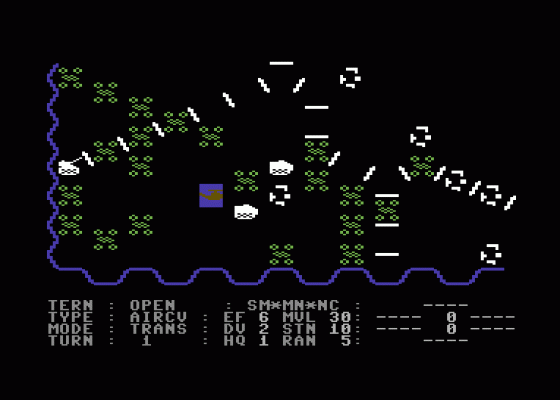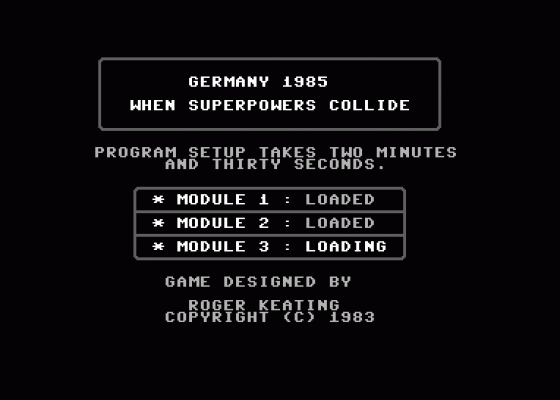
Zzap
 1st March 1986
1st March 1986
Categories: Review: Software
Publisher: Strategic Simulations Inc
Machine: Commodore 64
Published in Zzap #11
Germany 1985
This is the first in SSI's episodic When Superpowers Collide series. Each module in the series examines in detail a hypothetical conflict between US and Soviet forces. In Germany 1985 the idea is that Soviet forces have made their first hostile act against the NATO forces in West Germany's Southern Central region where American units constitute the main defensive force.
There are two scenarios. The first, Advance to Combat, involves Russian and US forces of comparable strength as they race to establish a cohesive front line. Invasion is the second scenario, which begins with Soviet airborne divisions landing behind NATO lines. Their mission is to block key roads and capture towns to prepare for the main advancing force. In both scenarios, the victory conditions are the same: the player controlling the greatest number of towns after a certain number of game turns is the winner.
One feature about SSI games is that they usually contain just about every play option you could possibly require. One or two player games are possible, with the computer playing either side during solitaire play. Different levels of difficulty may be selected. The terrain features may be randomized. A hex system (scale: one mile per hex) is employed for movement. Movement speed of a given unit is inversely proportional to the number of enemy units that can see it. Smoke screens may be generated to cover either attacks or retreats. Air strikes and air superiority are taken into account and units may be hidden for limited intelligence at the player's option.

Controlling different units is simplicity itself. Pressing F1 puts the cursor on the nearest unit under your command. The unit may then be moved up to its full movement point allocation in any direction (barring the presence of natural obstacles) by further movement of the cursor. In the bottom right hand corner of the screen, markers are set up in a hexagon to show which directions the vehicle currently under the cursor can move. Also displayed inside the hexagon is the number of enemy units which have spotted you, along with the enemy units sighted by you.
Units have several possible modes. Transport mode makes a unit easily and quickly movable, but only over road or clear terrain, and it also increases a unit's vulnerability. Defense mode means a unit is dug in to offer the most resistance, and therefore cannot be moved. Other modes include Support, meaning the unit will assist any units involved in combat within three hexes; Normal, a unit's standard deployment mode; River, allowing units to cross water obstacles; Attack, enhanced combat mode which also increases vulnerability to losses; Fire, which allows the employment of ranged weaponry and Reor, which allows the unit to refit to regain strength and efficiency. Changing mode is possible at any time during the movement phase, but costs movement points to do so.
The order phase offers a wide variety of orders which may be given to a unit ranging from strategic movements to take advantage of terrain, to delayed combat and opportunity fire at enemy targets. Artillery orders open up a whole range of possibility also. NATO forces have self propelled artillery battalions, whereas the Soviets have traditional artillery enhanced with Katyusha rocket launchers. Direct fire, support fire and opportunity fire are all possible, and the different kinds of round are also selectable.

Air power plays a major part in the game. Air strikes may be called in to attack enemy units on their own, or to assist a ground unit in its attack. Air superiority is determined by the computer based on the current scenario and each side's air activity during previous turns.
Combat is affected by as many factors as possible. This makes the combat sequences the most realistic I've come across in a tactical wargame. Yet the whole procedure is handled extremely quickly and it reveals the care, dedication and skill of the programmers responsible. The amount of information available on a given unit is really incredible. The game designers have packed in just about every conceivable consideration for a game on this scale. Although the scenarios are both non-nuclear, provision is made for the use of nuclear weapons in future scenarios using the same system.
Victory is difficult to achieve, no matter which side you play. The logic used by the computer is very complex indeed. Although both sides are of comparable strength, the different difficulty levels combined with the options on limited intelligence and different scenarios make this an extremely challenging game.
Once the basic rules have been assimilated, it is comparatively easy to play rapidly. There is of course, the option to save a game at any stage as the twenty-three turns the game can last make playing it to a conclusion a rather lengthy process. I felt my efforts rewarded simply by acknowledging that if I lost, at least the game itself wasn't at fault. It's excellently designed and highly playable. Advance to Combat is a limited scenario in that it assumes neither side has any distinct advantage over the other for simplicity. It does serve as an excellent vehicle for testing the parameters of the game, however. Invasion is the scenario you should aim to play, as achieving a substantial victory here is extremely difficult. And the scenario itself is more realistic.
Next month, I'll be taking a close look at both Norway 1985 and RDF 1985. Time did not permit playing either of them thoroughly enough for their inclusion this issue. If you are interested in the Superpowers series, remember that Germany 1985 must be bought before the others, as it's the only game which contains all the rules necessary for play. The others are only supplementary games. As an example of the confidence the game designers have in the series, all the tables and combat rules are included in full in an appendix. It would not take much to convert them to a highly playable set of conventional rules. All in all an excellent game.
Verdict
Presentation 95%
The best rules book, map, and selection of play options I've seen on a strategy game.
Graphics 87%
I've seen better graphics but these are still neat and clear.
Instructions 98%
Impeccable.
Authenticity 84%
The chances of having two evenly matched forces in any area of West Germany are relatively low.
Playability 96%
The complex rules are sufficiently well explained to allow rapid implementation.
Overall 97%
Amongst the best ever SSI releases.



